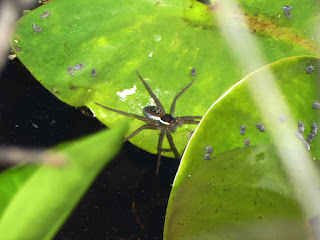Six-spotted Fishing Spider
Here's someone I didn't tell you about earlier because I didn't initially have an ID for it, and then when an iNaturalist provided me with an ID, I had moved on to other pictures. A more recent sighting of this species jogged my memory about this spider.
This is almost certainly a Six-spotted Fishing Spider, and while you might think it was named for the smallish white spots on its back, it's actually named for 6 black spots on its belly. As happens all too often, the characteristic that leads to its name works poorly as a field mark (see Ring-necked Duck).
As the name suggests, these spiders will catch (small) fish, but they're not especially picky eaters. If you're a small enough animal of any sort, you're probably on the menu. And of course if you're going to catch fish, you need to be pretty good around water. The SSFS can walk on the surface of the water or walk under the water. Because it can trap air in its abdominal hairs, it can breathe that air underwater and stay submerged for around half an hour.
These are more broadly categorized as nursery web spiders. Nursery web spiders don't use webbing to catch prey but will use it for a variety of other purposes, including making a little nursery out of web when a female's eggs are about to hatch. They'll also use it to go ballooning, and the fishing spiders will use drag lines when venturing out into the water.
Habitat aside, you might be thinking that these spiders remind you of wolf spiders; other people have noticed this too. The most visual difference is in the eyes; wolf spiders have 8 eyes but 4 prominent ones that usually form a trapezoid shape. Nursery web spiders don't have eyes as prominent and they form more of a curved line. Other than that your best bet for distinguishing between them is to ask where they like to carry their eggs:
- A nursery web spider will tell you that the only reasonable choice is to carry them in egg sacs in front of you.
- A wolf spider will tell you that's crazy, and eggs should be carried all the way behind to where your spinneret is.
Here's a short video about Six-spotted Fishing Spiders.
 |
| May 10, 2022 at Great Swamp National Wildlife Refuge Photo 197982507, (c) jpviolette, some rights reserved (CC BY-NC) |



Comments
Post a Comment